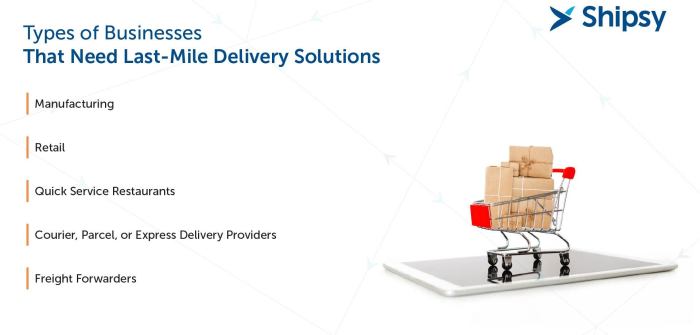Embark on a journey into the world of last-mile delivery solutions, where innovation meets practicality to revolutionize the transportation and logistics industry. Get ready for a deep dive into the strategies, challenges, and success stories that shape this crucial aspect of modern business operations.
Last-mile delivery solutions
In the transportation and logistics industry, last-mile delivery refers to the final step of the delivery process where goods are transported from a distribution center to the end customer’s location. This crucial stage often presents challenges due to the need for timely and efficient delivery in urban areas with high traffic and complex routes.
Examples of Innovative Last-Mile Delivery Solutions
- Amazon Prime Air: Amazon has been testing drone delivery services to expedite last-mile delivery and reduce transportation costs.
- UberRUSH: Uber’s delivery service allows businesses to offer same-day delivery to their customers by leveraging Uber drivers as couriers.
- Starship Technologies: This company uses autonomous robots to deliver packages within a two-mile radius, optimizing last-mile delivery in urban areas.
Importance of Efficient Last-Mile Delivery
Efficient last-mile delivery plays a crucial role in customer satisfaction and retention. Customers expect faster delivery times and real-time tracking of their orders. By providing seamless last-mile delivery solutions, businesses can enhance the overall customer experience and build brand loyalty.
Challenges in Implementing Last-Mile Delivery Solutions
- High Delivery Costs: Last-mile delivery is often the most expensive part of the supply chain due to the need for multiple stops and specialized services.
- Traffic Congestion: Urban areas face challenges with traffic congestion, making it difficult to deliver goods on time and impacting customer satisfaction.
- Reverse Logistics: Returns and exchanges add complexity to last-mile delivery, requiring efficient processes to handle reverse logistics effectively.
Textiles and Nonwovens
Textiles and nonwovens play a crucial role in providing sustainable and efficient packaging solutions for last-mile delivery. These materials offer a range of benefits, from durability and protection to eco-friendliness and innovation.
Role of Textiles and Nonwovens in Last-Mile Delivery
- Textiles and nonwovens are commonly used in packaging solutions for last-mile delivery due to their lightweight yet sturdy properties.
- These materials help protect products during transit, reducing the risk of damage and ensuring safe delivery to the end consumer.
Contribution to Eco-Friendly Packaging Alternatives
- Textiles and nonwovens are sustainable alternatives to traditional packaging materials like plastic and foam.
- These materials can be recycled and reused, reducing waste and environmental impact in the last-mile delivery process.
Significance of Durable and Protective Textiles
- Durable textiles are essential for shipping sensitive products such as electronics, glassware, and perishable goods.
- Protective textiles help cushion and secure items in transit, preventing breakage or damage during handling and delivery.
Innovative Textile Materials in Last-Mile Delivery
- Examples of innovative textile materials used in last-mile delivery solutions include recycled polyester, biodegradable fabrics, and antimicrobial textiles.
- These materials offer advanced functionalities like moisture-wicking, temperature control, and odor resistance, enhancing the quality and sustainability of packaging for e-commerce shipments.
Transportation and Logistics

In the realm of last-mile delivery solutions, transportation and logistics play a crucial role in ensuring efficient and timely delivery of goods to customers. The advancements in technology have significantly impacted the way last-mile deliveries are handled, leading to improved efficiency and customer satisfaction.
Impact of Technology on Last-Mile Delivery Efficiency
Technology has revolutionized last-mile delivery by introducing route optimization software, real-time tracking systems, and data analytics, allowing companies to streamline their delivery processes. By utilizing these technological tools, businesses can reduce delivery times, minimize fuel consumption, and enhance overall operational efficiency.
Role of Autonomous Vehicles and Drones
Autonomous vehicles and drones are increasingly being explored as innovative solutions for last-mile deliveries. These technologies offer the potential to reduce delivery costs, improve delivery speed, and minimize human errors. Autonomous vehicles, equipped with sensors and AI algorithms, can navigate through traffic and deliver packages efficiently. Similarly, drones can reach remote or congested areas quickly, making them ideal for rapid deliveries.
Comparison of Traditional vs Modern Transportation Methods
When comparing traditional transportation methods like manual delivery routes and conventional vehicles with modern solutions such as electric vehicles and delivery robots, it is evident that modern technologies offer greater speed, accuracy, and cost-effectiveness. Electric vehicles reduce carbon emissions, while delivery robots can navigate sidewalks and deliver parcels directly to customers’ doorsteps, enhancing convenience.
Future Trends in Transportation and Logistics for Last-Mile Delivery
Looking ahead, the future of transportation and logistics for last-mile delivery is poised for further innovation. Trends such as the adoption of electric vehicles, expansion of drone delivery services, and implementation of AI-powered delivery systems are expected to reshape the industry. Moreover, the integration of data analytics and IoT devices will enable companies to optimize delivery routes, track shipments in real-time, and provide personalized delivery experiences to customers.
Business Creation and Development
Starting a last-mile delivery service presents numerous opportunities for new businesses looking to enter the logistics industry. The rise of e-commerce has created a high demand for efficient and timely delivery services, making it a lucrative market for startups to tap into.
Opportunities for New Businesses
- Specialization in specific niches such as perishable goods, pharmaceuticals, or bulky items can help new businesses stand out in a crowded market.
- Offering innovative delivery solutions such as same-day or on-demand delivery can attract customers looking for convenience and speed.
- Collaborating with local businesses or retailers to provide last-mile delivery services can establish a strong network and customer base.
Competing with Established Providers
- Focus on providing superior customer service and building a reputation for reliability to differentiate from larger competitors.
- Utilize technology and data analytics to optimize delivery routes, reduce costs, and improve efficiency.
- Offer competitive pricing and flexible delivery options to attract and retain customers in a highly competitive market.
Implementing Sustainable Practices
- Adopting electric vehicles, bike couriers, or alternative delivery methods can reduce carbon emissions and appeal to environmentally conscious consumers.
- Implementing efficient route planning and delivery consolidation can decrease fuel consumption and lower overall environmental impact.
- Partnering with eco-friendly packaging suppliers and promoting recycling initiatives can further enhance the sustainability of the business.
Success Stories
- Company X implemented a real-time tracking system and personalized delivery options, resulting in a significant increase in customer satisfaction and retention rates.
- Startup Y focused on last-mile delivery for local farmers and small businesses, establishing strong community ties and expanding its services regionally.
- Business Z partnered with a non-profit organization to offer last-mile delivery of essential supplies to underserved communities, gaining positive publicity and customer loyalty.
Domestic Services
When it comes to last-mile delivery solutions, the impact on local businesses and communities is significant. These services play a crucial role in ensuring that products reach customers efficiently and on time, which can help boost sales for small businesses and improve overall customer satisfaction.
Small businesses often face challenges in adopting efficient last-mile delivery practices due to limited resources and infrastructure. They may struggle to compete with larger companies that have more advanced delivery systems in place. However, by partnering with third-party logistics providers or utilizing innovative technologies, small businesses can overcome these obstacles and enhance their delivery capabilities.
Improving Convenience for Domestic Consumers
- Last-mile delivery solutions can greatly improve convenience for domestic consumers by offering flexible delivery options, such as same-day or next-day delivery, as well as real-time tracking of shipments. This allows customers to receive their orders quickly and with transparency, enhancing their overall shopping experience.
- By leveraging technologies like route optimization and geolocation tracking, last-mile delivery companies can ensure timely and accurate deliveries, minimizing the chances of missed or delayed shipments. This level of efficiency can make the entire delivery process seamless and hassle-free for consumers.
- Additionally, the availability of on-demand delivery services and secure drop-off locations can further enhance convenience for domestic consumers, providing them with more control over when and where they receive their packages.
Partnerships Between Domestic Service Providers and Last-Mile Delivery Companies
- Many domestic service providers, such as local retailers, restaurants, and grocery stores, have started partnering with last-mile delivery companies to offer delivery services to their customers. This collaboration allows these businesses to expand their reach and cater to a wider audience without investing in their delivery infrastructure.
- By working together, domestic service providers and last-mile delivery companies can streamline the delivery process, reduce costs, and improve overall customer satisfaction. These partnerships enable businesses to focus on their core operations while leaving the logistics and transportation aspect to experts in the field.
- Some examples of successful partnerships include local bakeries partnering with delivery platforms to offer fresh bread and pastries to customers’ doorsteps, or neighborhood pharmacies teaming up with couriers to deliver prescription medications to patients in a timely manner.
Translation Services
In the realm of last-mile delivery solutions, multilingual support plays a crucial role in ensuring effective communication with customers across different language barriers. This is where translation services come into play, offering a way to bridge the gap and enhance the overall customer experience in the delivery process.
Importance of Multilingual Support
- Facilitates clear and accurate communication with customers who speak different languages.
- Helps in providing essential delivery information such as tracking updates, delivery times, and order details in a language that the customer understands.
- Improves customer satisfaction by showing that the company values and respects its diverse customer base.
Integration of Translation Services
- Utilize automated translation tools to quickly translate essential messages and notifications into multiple languages.
- Offer language selection options on the delivery platform to allow customers to choose their preferred language for communication.
- Train customer service representatives to handle queries and issues in different languages to provide personalized support.
Examples of Effective Use
- Amazon uses translation services to provide product information and customer support in multiple languages, enhancing the shopping and delivery experience for customers worldwide.
- UPS employs translation services to communicate delivery updates and tracking information to customers in their preferred language, ensuring clarity and convenience.
- DHL integrates translation services into its delivery platform to offer a seamless experience for customers in different regions, creating a more inclusive and customer-centric approach.
Final Wrap-Up
As we wrap up our exploration of last-mile delivery solutions, remember that efficiency and customer satisfaction are at the heart of successful logistics. Stay tuned for more exciting developments in this dynamic field!
FAQ Compilation
How do last-mile delivery solutions impact customer loyalty?
Last-mile delivery solutions play a crucial role in enhancing customer satisfaction by ensuring timely and convenient delivery, which in turn boosts customer loyalty.
What are the key challenges faced by businesses in implementing last-mile delivery solutions?
Businesses often struggle with optimizing routes, managing costs, and maintaining high service levels while implementing last-mile delivery solutions.
How can startups compete with established delivery service providers in the last-mile delivery sector?
Startups can differentiate themselves by offering unique services, focusing on niche markets, and leveraging technology to streamline operations and enhance customer experience.
Why is it important for last-mile delivery companies to adopt sustainable practices?
Implementing sustainable practices not only benefits the environment but also enhances brand reputation, attracts eco-conscious customers, and contributes to long-term business growth.
What role do autonomous vehicles and drones play in modern last-mile delivery solutions?
Autonomous vehicles and drones are revolutionizing last-mile delivery by enabling faster, more efficient, and cost-effective delivery options, especially in urban areas with high traffic congestion.





